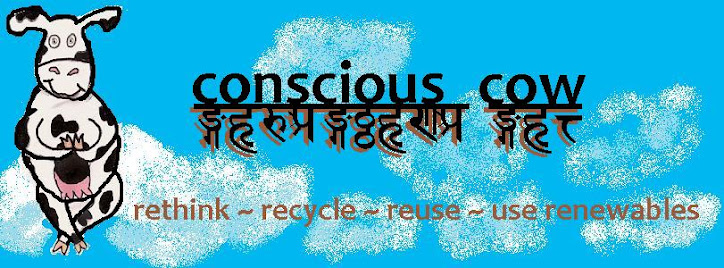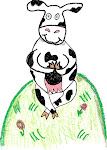
Conscious Cow chats with CET's JAMIE CAHILLANE:
(originally printed March 19th at the Cow's old blogsite)
Jamie Cahillane, of the Center for Ecological Technology in Pittsfield, Massachusetts, runs CET’s annual Earth Day Textile Drive. Conscious Cow caught up with Jamie today to get more information about textile recycling.
Cow: Why should people recycle textiles?
Jamie: Textiles constitute about 5% of the waste stream. It’s a good way to divert more material and to reduce the volume of waste that goes in the landfill or incinerator. If you think about it; it’s also a way to save energy. There’s a lot of energy that goes into the production of new fabric, whether it’s a natural fiber or oil based fiber. Once it’s made, the energy content is already in place. If you can recycle or reuse it, you’re actually saving energy.
Jamie says there are two possible applications for the fabric claimed at a Textile Drive.
1. RE-USINGCET partners with Goodwill Industries. If the clothing still "has life' in it, it will find it's way onto the bod of some happy discount shopper at one of their stores.
2. RECYCLINGIf the textile can't be re-used, the folks at Goodwill either cut it into rags, or they bale it up and ship it to a textile market, where it can be resold and ultimately made into new fabric.
Cow: Do you know of textile drives in other states?
Jamie: This is very unique. I don’t think anyone else does this [except] when a college has move-out. They’ll collect things and donate to charities. This is CET's 14th drive, and it’s unique because it is a way for people to donate materials. and it’s a way to raise awareness.
Last year we collected 26,000 pounds of clothes.
****************************************
Conscious Cow FACT: 26,000 pounds of clothing is enough to fill a semi-trailer.
Although Goodwill pays CET for the clothes collected, the endeavor is not profitable enough to support what CET does. CET organizes the Textile Drive each year to raise people’s consciousness about the clothing and textiles that should be reused or recycled. It’s also an opportunity for CET to tell people about the other things they do, such as working with utilities to coordinate energy conservation audits, and coordinating hazardous waste collection. CET even sells lightbulbs.
Jamie & Conscious Cow agree: it's time to raise consciousness about clothing and textiles! As part of the waste stream, fabric should be treated like paper.
It's up to you! Don't toss it in the trash; clean it up and make available for someone else to use. Re-use it or Recycle it!
If you live outside of CET's service area, Jamie encourages you to donate your old clothes, curtains, and other fabrics to organizations such as Goodwill, Salvation Army, or a local religious organization or community center. There are opportunities to donate clothing no matter where you are.
FOR MORE INFO, see the NEWS FLASH posted earlier today, or visit CET's website:
http://www.cetonline.org/











